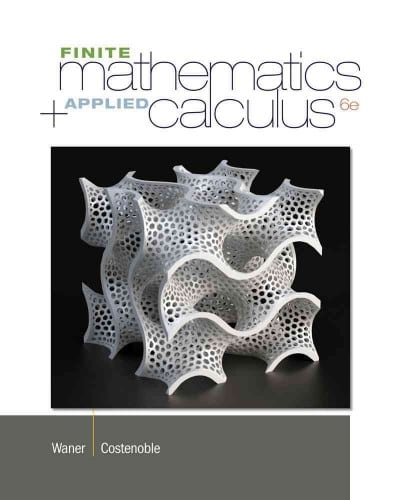Question
There are 4 balls in an urn. Each ball is either red or black.You start by believing that the probabilities that the urn contains 0,
There are 4 balls in an urn. Each ball is either red or black.You start by believing that the probabilities that the urn contains 0, 1, 2, 3, 4 red balls are all equal. You then reach into the urn and pull out a ball at random. It is red. Compute the new probabilities that the urn contains 0, 1, 2, 3 or 4 red balls.PlayMuteLoaded: 0%Progress: 0%Remaining Time-0:47Playback Rate1xCaptionsFullscreen
Like
Share
Bookmark
Answer
Selecting Colored Balls Urn 1 contains 5 red balls and 3 black balls. Urn 2 contains 3 red balls and 1 black ball. Urn 3 contains 4 red balls and 2 black balls. If an urn is selected at random and a ball is drawn, find the probability it will be red.
DiscussionCancelDiscussVideo Transcript
in here basically gives us three different earns. So we label as earned one. Um, if I changed a suit, another color earned two and then earned three here. So with earned one, we know that there is going to be five. Fred, um, and three black balls for earn to theirs could be three red and one black for in three dirty and before red and two black. So it asked if Ernest selected at random and a ball is drawn, find the probability that will be read. So in orderto find this probability to find the probability that first of all, it's going to be found in earned one and also bread on we added to the probably of two and red and three and red. So first of all, let's take this scenario of one and red. So what's the probability that it's going? We're going to select earned one, so there's gonna be three different earned, So the probably that we're gonna find that is gonna be 1/3. And the probability that was in this urn itself that it's gonna be red is going to be five, so that would be multiplied by 5/8 Azar's eight total. And we basically add this to one of her three again, Um, And then we multiply this by 3/4, and we add this to 1/3, multiplied by 4/6. So from here, it'll be fine over 24 plus 3/12 um, and then plus 4/18. So from here, we need to find in order to for so add fractions here. Of course, we need to find the least common multiple between all of these. And this is gonna be 72. Um, where for? So with 20 four, we multiply three times against 72 with 12 months by six times to get 72 with 18 we multiply by four times to get 72 that is going to give us a total of, um, 49 out of 72 here
Alexander C.University of California - Los AngelesElementary Statistics a Step by Step Approach
Chapter 4
PROBABILITY AND COUNTING RULES
Section 3
THE MULTIPLICATION RULES AND CONDITIONAL PROBABILITY
Top Intro Stats / AP Statistics EducatorsCatherine R.
Missouri State University
MCMegan C.
Piedmont College
Monique R.
Numerade Educator
Heather Z.
Oregon State University
Intro Stats / AP Statistics Bootcamp
Lectures
0:00
Data And Variables
0:00
Data And Variables - Example 1
Join BootcampRecommended Videos
02:45
An urn contains 3 green ba...
03:44
Urn A has three red balls ...
02:27
Consider 3 urns. UrnAAc...
06:46
An urn contains 3 red ball...
About
- Our Story
- Careers
- Our Educators
- Numerade Blog
Browse
- Courses
- Books
- Test Prep
Support
- Help
- Privacy Policy
- Terms of Service
Step by Step Solution
There are 3 Steps involved in it
Step: 1

Get Instant Access to Expert-Tailored Solutions
See step-by-step solutions with expert insights and AI powered tools for academic success
Step: 2

Step: 3

Ace Your Homework with AI
Get the answers you need in no time with our AI-driven, step-by-step assistance
Get Started


